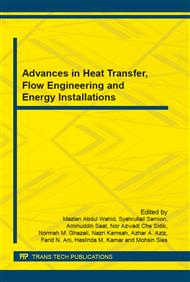p.287
p.295
p.300
p.305
p.309
p.314
p.319
p.326
p.330
Effects of Two-Phase Flow Friction Factor Correlations on the Optimal Pressure Drop-Martinelli Parameter Pair in a Mini-Channel
Abstract:
Substantial research has been completed with more on-going on the flow pattern and heat transfer associated with two-phase flows. Discrepancies reported may have been as much as agreements, due to the different models, approaches, flow regimes, correlations, and new working fluids being utilized. This paper reports the outcome of a study to look at the effects of applying two different friction factor correlations on the simultaneous minimization of the pressure drop and Martinelli parameter under optimized flow rate and vapor quality, using genetic algorithm. The homogeneous model is assumed with ammonia as the working fluid, the coolant being environmentally friendly and having recently discovered as a potential replacement for the current refrigerants in micro and mini-channels. Results show that significant differences in the frictional pressure drop and Martinelli parameter arise due to the different correlations used, and this is only the outcome from two different correlations currently being considered by researchers in pressure drop analysis for two-phase flows in mini-channels. Thus, absolute agreement is indeed not possible between theoretical, experimental, and numerical work in view of the many different available correlations being utilized today with differences between 10 to 100 percent that has already been established.
Info:
Periodical:
Pages:
309-313
Citation:
Online since:
January 2016
Price:
Сopyright:
© 2016 Trans Tech Publications Ltd. All Rights Reserved
Share:
Citation:


